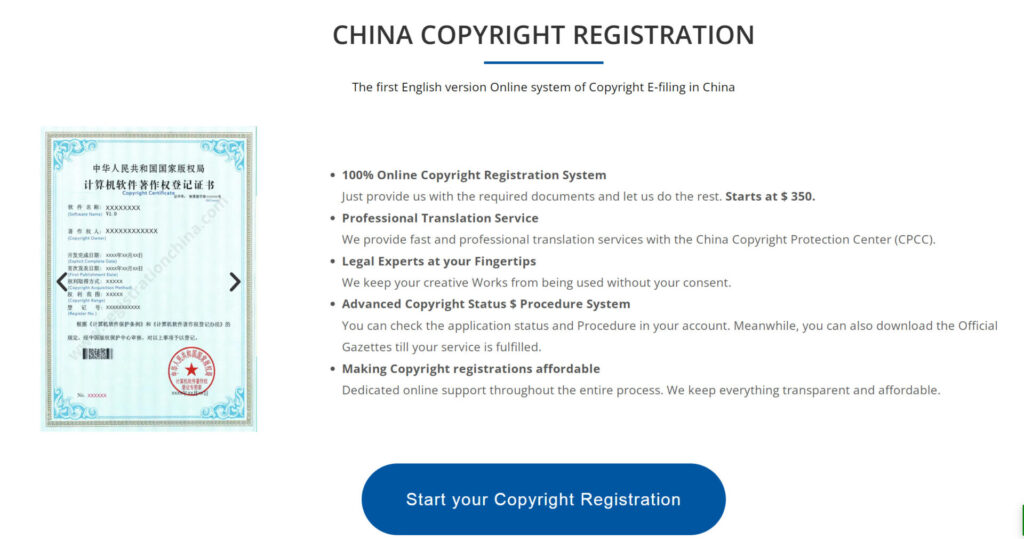Contents
Introduction:
In the digital era, intellectual property (IP) protection is pivotal for software developers and companies worldwide. In China, a burgeoning technology market, safeguarding the fruits of innovation is not just a legal matter, but a cornerstone of business strategy. This article guides you through the steps of registering the Computer Software Copyright of China, detailing procedures, legal frameworks, and best practices.
Understanding Chinese Intellectual Property Law of Computer Software Copyright
China’s legal landscape for intellectual property rights (IPR) has continually evolved to meet international standards and practices. The primary legislation governing copyright is the Copyright Law of the People’s Republic of China, which offers protection for computer software. To further strengthen the integrity of the digital space, the Ministry of Industry and Information Technology issued the “Notice on carrying out the work of filing mobile internet applications,” mandating the filing of mobile apps and the initiation of ICP records for websites within the mainland.
Preparation: Before the Computer Software Copyright Registration Process Begins
Before delving into copyright registration, entities must navigate the preliminary requirements unique to China. Foreign entities aiming to launch a website in China must start with an ICP filing, a necessity for hosting and operating a web-based service. Similarly, app developers must file their mobile applications as dictated by the industry ministry’s notice. Both serve as prerequisites for further IP protection steps and signify compliance with local regulations.
The Registration Process of Computer Software Copyright: Step by Step
The process of registering computer software copyright in China involves several meticulous stages. It starts with establishing a presence in the form of a foreign-invested enterprise (FIE), which plays a pivotal role in the registration process as the legal entity holder of the copyright. Here’s a breakdown of the steps:
1. Setting Up an FIE in China:
Before you can register any IP, you’ll need to establish your business officially in China. This includes selecting a business scope, registering for taxes, and securing a local office address.
2. Signing an Agreement with GWBMA:
Engage with a reputable local agency, such as GWBMA, to facilitate the process. They can assist with navigating complex legal procedures and liaising with local authorities.
3. Filing for Copyright:
Once your FIE is established, leverage platforms like RegistrationChina to initiate the copyright application. You’ll select ‘Computer Software Copyright’ and provide necessary documentation such as the software source code, a description, and proof of originality.
4. .cn Website Registration:
With your FIE, you can also register a .cn domain for a more genuine presence in China, further protecting your software brand and facilitating marketing efforts.
Using RegistrationChina’s Platform of Computer Software Copyright Online
RegistrationChina offers a streamlined pathway for software copyright application submission. The platform simplifies the process of submitting required materials and ensures compliance with the stipulations laid down by Chinese IP law. By choosing the Computer Software Copyright category, applicants are guided through the necessary steps and documentation to secure their rights effectively.
Post-Registration: Ownership and Transfers
After successfully registering the copyright, it’s essential to consider ownership and transfer mechanisms. For foreign entities, transferring the rights to the newly established FIE can be a protective measure and serves compliance purposes. This legal maneuver should be done under the advisement of legal professionals to ensure all transfers uphold Chinese regulations.
Solutions for Real-Name Authentication in China Computer Software Copyright Applications
In China, the Mobile Phone number real-name authentication is an indispensable step in the application process for computer software copyrights. For enterprises or individuals within China, completing the Mobile Phone real-name authentication is relatively straightforward, as they can directly use local identification and contact information for verification. However, for those outside of China, the Mobile Phonereal-name authentication and acquiring a Chinese Mobile Phone number can pose significant barriers, severely limiting their ability to protect their intellectual property.
For foreign enterprises and individuals, due to the lack of Chinese identification documents and local contact numbers, completing Mobile Phone number real-name authentication directly is nearly impossible. This not only delays the copyright application process but may also prevent the protection of software innovations in the Chinese market. In this case, finding an effective solution becomes crucial.
In facing this challenge, choosing GWBMA as your representative is the key to solving the real-name authentication issue. As a professional agency, GWBMA possesses all the qualifications and experience required for applying for software copyrights in China. We can act as your representative, using our identity information and contact details to complete the real-name authentication process for you, ensuring that your application is not hindered by real-name authentication barriers.
Conclusion:
Securing copyright in China for computer software is an intricate process that necessitates diligence, attention to detail, and a willingness to navigate bureaucratic pathways. By understanding the legal requirements, engaging with professional agencies, and utilizing platforms such as RegistrationChina, companies can effectively protect their software innovations in the Chinese market.
Please read the China Copyright: The Most Comprehensive and Quickest Guide.



